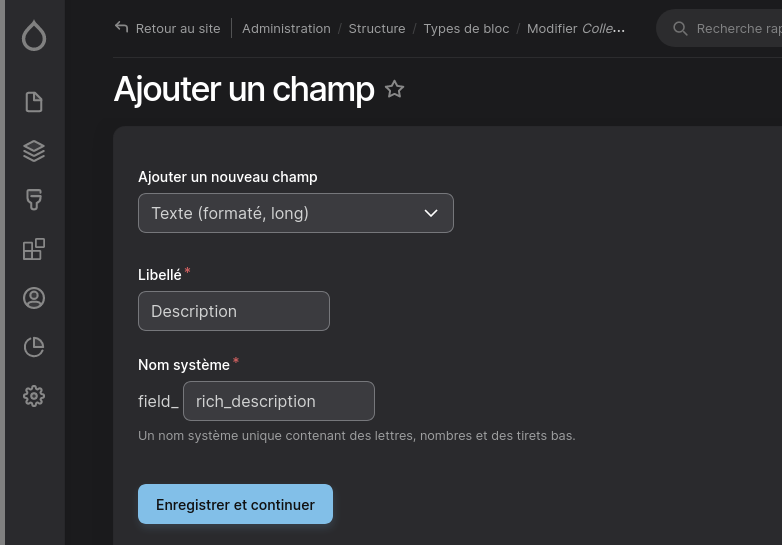Migrating data from an old field to a new field
2024-05-07
It happens to everyone. You created a field for a block, to be used in layout builder, and turns out you actually need to change the field type.
It should have been formatted, but it's not.
For this little how-to, I will assume you are using the Drupal config management system and ddev.
If you're not using ddev, just remove it from the commands 😊.
This little how-to is specific to new fields in block_content, like the blocks used in layout builder.
The plan is to:
- Create the new field
- Export the configuration
- Write three functions, called hook updates
- Test everything
- Remove the old field and re-export the configuration
1. Creating the new field
In my case, my old field is called field_description while the new one is called field_rich_description, which accepts HTML content.
To make sure I don't have too many configs exported later on, I will import the config right now to make sure my DB is up-to- date with my config files.
ddev drush cim -y
I will use the Drupal Field UI to create the new field.

Once the field is added and configured to my taste, it's time to export the new configuration.
2. Exporting configuration
ddev drush cex -y
If you haven't run cim in step one, you might end up with a lot of changes, depending on your initial state.
Your result should be similar to this :

The thing we really care about is the first two files :
- field.storage.block_content.field_rich_description
- field.field.block_content.collector_page_header.field_rich_description
The other two are important, but not for migrating the data. So git commit those as well, but we don't care about it for now.
3. Writing the three hook updates
Normally after a deployment, we want to execute those commands in this order :
- drush cr (cache rebuild)
- drush updatedb
- drush config:import (cim)
The updatedb, also called a hook update,
is a perfect place to run our migration steps, but we have a "Chicken or the egg" issue here.
The configuration of our new field will be imported in the last step only. The other issue is the deleting of the old field, which should
also happen when we run the config:import, making this less than ideal to migrate the data.
So we will create three functions hook_update_N to:
- Read and import the configuration files for our new field
- Migrate the data into the new field
- Delete the old field
The hook_update_N functions must be located in one of your custom module, specifically in the .install.
For this how-to, let's call your custom module my_module.
For our first function, in our file named my_module.install:
function my_module_update_1001() {
$config_storage = new \Drupal\Core\Config\FileStorage(Drupal\Core\Site\Settings::get('config_sync_directory'));
foreach ([
'field.storage.block_content.field_rich_description',
'field.field.block_content.collector_page_header.field_rich_description',
] as $config_name) {
$entity_type = \Drupal::service('config.manager')
->getEntityTypeIdByName($config_name);
$storage = \Drupal::entityTypeManager()->getStorage($entity_type);
$config_record = $config_storage->read($config_name);
/** @var \Drupal\Core\Config\Entity\ConfigEntityStorageInterface $storage */
$entity = $storage->createFromStorageRecord($config_record);
if ($storage->load($entity->id())) {
\Drupal::logger('my_module')->info('my_module_update_1001: config already imported, ignoring.');
} else {
try {
$entity->save();
} catch (\Drupal\Core\Entity\EntityStorageException $exception) {
\Drupal::logger('my_module')->error('my_module_update_1001: ' . $exception->getMessage());
}
}
}
}
Make sure to change the field.storage.block_content.field_rich_description for the file extracted in step 2.
It's important to put the file named field.straoge.block_content.... first. If you don't, Drupal won't know how to add
the field because it doesn't have the storage settings.
For our second function, small reminder
my old field was named field_description and the new one is called field_rich_description :
function my_module_update_1002() {
$nids = \Drupal::entityQuery('block_content')->condition('type','my_block_type')->accessCheck(FALSE)->execute();
$blocks = \Drupal\block_content\Entity\BlockContent::loadMultiple($nids);
foreach($blocks as $block_content) {
$current_value = $block_content->get('field_description')->getValue();
if (!empty($current_value)) {
$current_value = \Drupal\Component\Utility\Xss::filter($current_value[0]['value']);
$block_content->set('field_rich_description', $current_value);
try {
$block_content->save();
} catch (\Drupal\Core\Entity\EntityStorageException $exception) {
\Drupal::logger('my_module')->error('my_module_update_1002: ' . $exception->getMessage());
}
}
}
}
I'm doing basic filtering with Xss::filter, but nothing crazy. Then I'm just copying the data into the new field.
And lastly, one last function to delete the old field, field_description.
Keep in mind this one is kind of optional;
you could delete the field from the UI then export the config.
I just find it cleaner.
function my_module_update_1003() {
$field = \Drupal\field\Entity\FieldConfig::loadByName(
'block_content',
'my_block_type',
'field_description',
);
if ($field !== NULL) {
$field->delete();
} else {
\Drupal::logger('my_module')->info('my_module_update_1003: field already deleted.');
}
}
4. Testing everything
Here's an easy way to test all the hooks with Drush:
ddev drush php-eval "\Drupal::moduleHandler()->loadInclude('my_module', 'install'); my_module_update_1001();" -vv
ddev drush php-eval "\Drupal::moduleHandler()->loadInclude('my_module', 'install'); my_module_update_1002();" -vv
ddev drush php-eval "\Drupal::moduleHandler()->loadInclude('my_module', 'install'); my_module_update_1003();" -vv
5. Deleting the old field
We are deleting the field in the last function, but we still want to make sure our configurations are up-to-date with those changes.
If we don't, the field might be recreated at the next drush cim.
ddev drush cex -y
Conclusion
I hope it was useful to you! This how-to is specific to block fields, but could be easily adapted to content types as well. I'm planning to make another article dedicated to content types soon-ish.